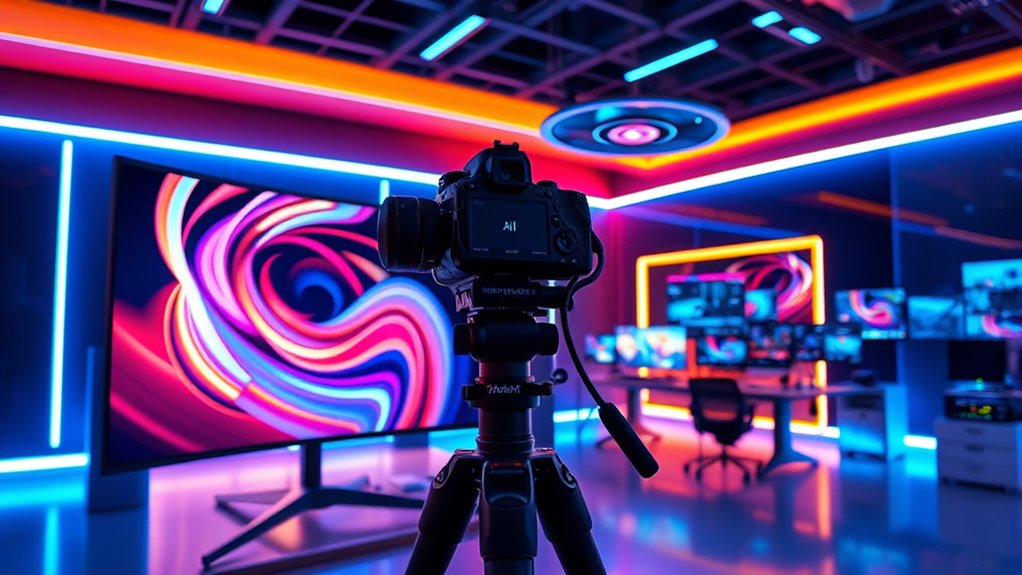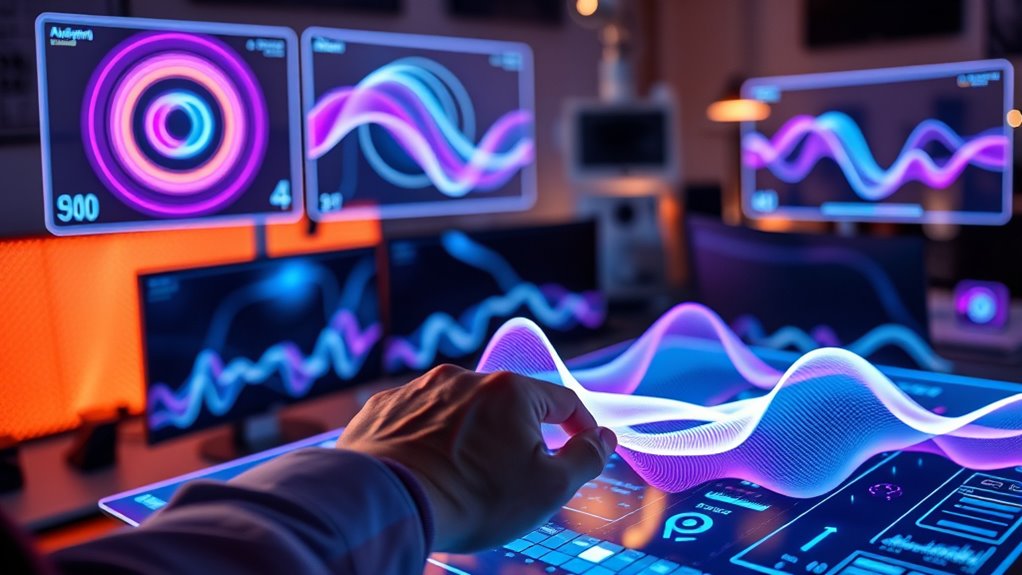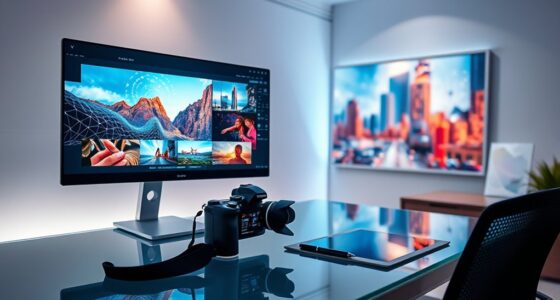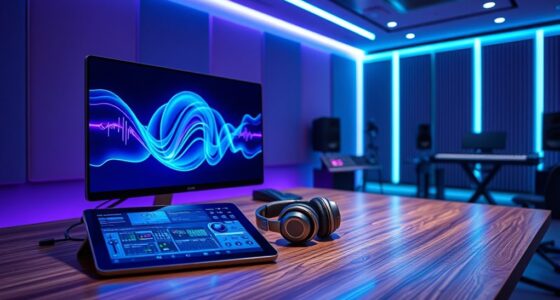AI is transforming motion graphics by automating tasks like frame interpolation, character rigging, and texture creation, markedly speeding up production. It enables real-time rendering, making complex projects more accessible and cost-effective. AI tools also improve viewer engagement and allow for more immersive VR and AR experiences. As these technologies continue to evolve, you’ll discover even more innovative ways to create and customize stunning videos efficiently.
Key Takeaways
- AI automates frame interpolation and texture generation, transforming text descriptions into detailed motion graphics faster.
- Real-time rendering tools enable instant visualization and editing directly from textual prompts.
- AI-driven character rigging and motion retargeting adapt animations to different styles or rigs based on text input.
- Integration with VR/AR allows interactive, immersive experiences generated dynamically from textual instructions.
- Emerging AI platforms predict movements and customize animations, making complex visual content accessible from simple text descriptions.
The Rise of AI-Driven Automation in Motion Graphics

The rise of AI-driven automation is transforming motion graphics by streamlining tasks that once took hours or days to complete. You can now automate repetitive processes like frame interpolation, texture generation, and character rigging, drastically reducing manual effort. Real-time rendering tools cut animation production time by up to 40%, helping you deliver projects faster. AI-powered features generate in-between frames automatically, decreasing animation time by 60-70%. Motion retargeting adjusts motion capture data seamlessly across different character rigs, boosting efficiency. Integrating AI tools into your workflow allows you to focus more on creativity and storytelling instead of tedious technical tasks. This shift not only accelerates production but also enhances the quality and sophistication of your motion graphics, opening new possibilities for innovation.
Market Impact and Economic Benefits of AI in Animation

AI is revolutionizing the animation industry by considerably boosting market growth and delivering substantial economic benefits. The global Generative AI animation market was valued at $2.1 billion in 2024 and is projected to reach $15.9 billion by 2030, with a CAGR of 39.8%. This rapid expansion results in significant cost savings, with sectors like marketing experiencing up to 70% reductions in production expenses. Additionally, AI-driven content enhances viewer engagement by up to 50%, boosting revenue opportunities. Independent studios benefit from shorter timelines—around 30% faster—and lowered costs by approximately 25%. The integration of AI also leverages advanced technology to further optimize animation workflows, leading to more innovative and dynamic content creation. Overall, AI’s integration accelerates production cycles, improves quality, and democratizes content creation, creating a more efficient, profitable, and accessible animation landscape for creators and businesses alike.
Key AI Tools Shaping Modern Motion Design

Numerous innovative AI tools are transforming how modern motion designers create and refine their work. These tools automate repetitive tasks like frame interpolation, character rigging, and texture generation, saving you time and effort. Real-time rendering speeds up projects, allowing quicker delivery. AI-powered features such as automated in-between frame generation and motion retargeting improve efficiency and animation fluidity. Popular tools include Vyond, Kaiber AI, Reallusion iClone, and Runway ML, each offering unique capabilities like body control, texture creation, and predictive editing. These tools streamline workflows, letting you focus on storytelling. Additionally, the integration of AI raises data privacy concerns that designers need to consider when utilizing these technologies. Here’s a quick overview:
| Tool | Main Feature | Use Case |
|---|---|---|
| Vyond | Automated character animation | Explainer videos |
| Kaiber AI | Texture and scene generation | Creative concept design |
| Reallusion iClone | Motion retargeting and rigging | Character animation |
| Runway ML | Frame interpolation and editing | Smooth transitions |
Merging AI With VR and AR for Immersive Experiences

Merging AI with virtual reality (VR) and augmented reality (AR) is revolutionizing immersive experiences by enabling real-time, interactive content creation. You can now generate realistic character behaviors, gestures, and environments on the fly, making VR and AR applications more dynamic and engaging. AI integrates seamlessly with game engines like Unreal and Unity, allowing live mocap streaming and immediate visual feedback. This accelerates collaboration among designers, performers, and developers, reducing production time and costs. Markerless motion capture powered by AI lowers technical barriers, making immersive content accessible to more creators. Whether for training, education, or entertainment, AI-enhanced VR and AR foster hyper-realistic, participatory experiences that adapt to user interactions, transforming how you design and experience virtual worlds.
Creative Possibilities Enabled by AI-Enhanced Animation

Enhanced animation capabilities are opening up a world of creative possibilities by allowing artists and designers to push boundaries previously limited by technical constraints. With AI, you can craft hyper-realistic motions, automate tedious tasks, and explore innovative storytelling techniques. AI-powered tools enable you to generate seamless progressions, enhance motion smoothing, and create detailed textures effortlessly. You can personalize content to match specific audience preferences, making stories more engaging and relevant. Automated lip-syncing, gesture control, and predictive animation give you more time to focus on creative vision rather than technical chores. Additionally, understanding spiritual symbolism can inspire more meaningful and resonant visual narratives. As a result, your projects become more dynamic, immersive, and visually striking. AI’s capabilities empower you to experiment boldly, break new ground, and elevate your motion graphics to levels previously unimaginable.
Future Directions and Emerging Technologies in AI Motion Graphics

As AI motion graphics continue to evolve, the focus shifts toward developing fully automated tools that can generate, refine, and customize animations with minimal human intervention. You’ll see machine learning predict and enhance movements, reducing errors and improving quality. Automation will streamline frame creation, making complex projects faster and more accessible. Expect AI to democratize production, empowering smaller studios to produce high-quality content efficiently. Additionally, scalable platforms will offer customizable solutions, adapting to diverse project needs. Industry efforts will concentrate on overcoming technical, creative, and talent challenges, pushing AI integration deeper into workflows. User engagement and feedback mechanisms will also play a crucial role in refining AI-generated content.
Frequently Asked Questions
How Does AI Ensure the Originality of Generated Motion Graphics Content?
AI helps guarantee the originality of your motion graphics by analyzing existing content to avoid repetitive patterns. It generates unique designs and animations through machine learning algorithms that adapt to your input, creating fresh ideas. You can customize AI outputs further, adding personal touches. This process encourages innovation, making your content stand out while maintaining creative integrity, ensuring your motion graphics remain distinctive and original.
What Are the Ethical Considerations of Ai-Generated Animations?
You should consider that AI-generated animations raise ethical questions about originality, authorship, and consent. Remarkably, the AI animation market is projected to grow from $2.1 billion in 2024 to $15.9 billion by 2030, highlighting its increasing influence. You need to ensure transparency about AI’s role, respect intellectual property rights, and avoid misrepresentation to maintain trust and uphold ethical standards in your creative work.
Can AI Replace Human Animators Completely in Motion Graphics Creation?
AI can’t fully replace human animators in motion graphics creation because it lacks the creativity, emotional insight, and storytelling nuance that humans bring. While AI automates repetitive tasks and speeds up production, you still need your artistic vision and decision-making skills to craft compelling, unique content. Think of AI as a powerful tool that enhances your work, allowing you to focus more on creative aspects rather than replacing the human touch entirely.
How Secure Is AI Technology in Protecting Intellectual Property Rights?
AI technology’s security in protecting intellectual property rights varies. You need to implement robust measures like encryption, access controls, and watermarks to guard your creations. While AI tools can help detect unauthorized use, they aren’t foolproof. Stay proactive by monitoring your content and updating security protocols regularly. This way, you’re better equipped to safeguard your work and prevent infringement, ensuring your ideas remain protected.
What Skills Will Future Motion Graphic Artists Need to Work With AI Tools?
You’ll need to master technical skills, develop creative intuition, and embrace continuous learning to work effectively with AI tools. You’ll need to understand AI algorithms, adapt to new software updates, and harness automation for storytelling. You’ll need to analyze data, refine designs, and innovate visually. You’ll need to collaborate seamlessly, communicate clearly, and stay curious. These skills enable you to leverage AI’s potential, push creative boundaries, and stay competitive in the evolving motion graphics industry.
Conclusion
As AI continues to reshape motion graphics, you’re standing at the forefront of a creative revolution. It’s like having a powerful brush that paints your imagination into vibrant reality, breaking barriers you never thought possible. Embrace these innovations, and you’ll open endless possibilities to captivate and inspire. The future of AI-driven animation isn’t just coming — it’s already here, ready to elevate your work to new heights and turn your visions into breathtaking realities.









